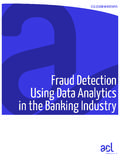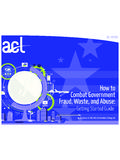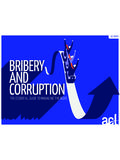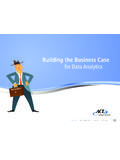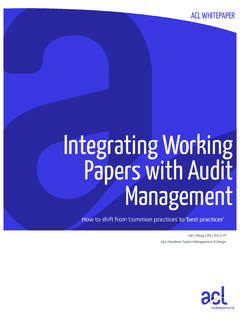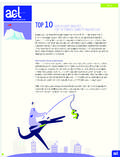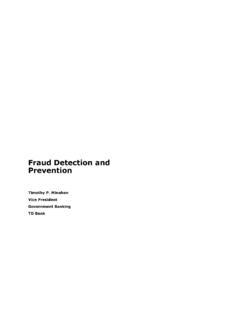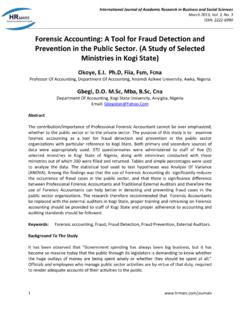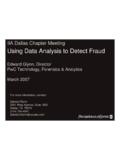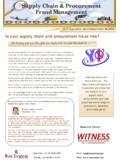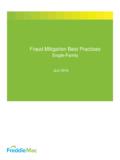Transcription of Fraud Detection Using Data Analytics in the Healthcare ...
1 DISCUSSION WHITEPAPER Fraud Detection Using data Analytics in the Healthcare Industry2 DISCUSSION PAPERT able of ContentsWHAT IS Fraud ? ..3 WHO IS RESPONSIBLE FOR Fraud Detection ? ..3 WHY USE data ANALYSIS FOR Fraud Detection ? ..4 ANALYTICAL TECHNIQUES FOR Fraud Detection ..5 Fraud Detection PROGRAM STRATEGIES ..5 TIME AND ATTENDANCE ANALYSIS UNCOVERS Fraud ..6 Healthcare ..6 Healthcare RELATED Fraud SCHEMES ..6 OTHER RESOURCES ..7 ABOUT ACL ..83 DISCUSSION PAPERWhat is Fraud ? Fraud encompasses a wide range of illicit practices and illegal acts involving intentional deception or misrepresentation. The Institute of Internal Auditors International Professional Practices Framework (IPPF) defines Fraud as: .. any illegal act characterized by deceit, concealment, or violation of trust.
2 These acts are not dependent upon the threat of violence or physical force. Frauds are perpetrated by parties and organizations to obtain money, property, or services; to avoid payment or loss of services; or to secure personal or business advantage. Fraud impacts organizations in several areas including financial, operational, and psychological. While the monetary loss owing to Fraud is significant, the full impact of Fraud on an organization can be staggering. The losses to reputation, goodwill, and customer relations can be devastating. As Fraud can be perpetrated by any employee within an organization or by those from the outside, it is important to have an effective Fraud management program in place to safeguard your organization s assets and is Responsible for Fraud Detection ?
3 While senior management and the board are ultimately responsible for a Fraud management program, internal audit can be a key player in helping address Fraud . By providing an evaluation on the potential for the occurrence of Fraud , internal audit can show an organization how it is prepared for and is managing these Fraud risks. In today s automated world, many business processes depend on the use of technology. This allows for people committing Fraud to exploit weaknesses in security, controls or oversight in business applications to perpetrate their crimes. However, the good news is that technology can also be a means of combating Fraud . Internal audit needs to view technology as a necessary part of their toolkit that can help prevent and detect Fraud . Leveraging technology to implement continuous Fraud prevention programs helps safeguard organizations from the risk of Fraud and reduce the time it takes to uncover fraudulent activity.
4 This helps both catch it faster and reduce the impact it can have on Detection Using data Analytics in the Healthcare IndustryThe International Professional Practices Framework (IPPF) contains the following Standards on Fraud and internal audit s role: 1200 Proficiency and Due Professional Care 1210-A2 Internal auditors must have sufficient knowledge to evaluate the risk of Fraud and the manner in which it is managed by the organization, but are not expected to have the expertise of a person whose primary responsibility is detecting and investigating Fraud . 1220 Due Professional Care Internal auditors must exercise due professional care by considering the following: Extent of work needed to achieve the engagement s objectives; Related complexity, materiality, or significance of matters to which assurance procedures are applied; Adequacy and effectiveness of governance, risk management, and control processes; Probability of significant errors, Fraud , or noncompliance; and Cost of assurance in relation to potential benefits.
5 2060 Reporting to Senior Management and the Board The chief audit executive must report periodically to senior management and the board on the internal audit activity s purpose, authority, responsibility, and performance relative to its plan. Reporting must also include significant risk exposures and control issues, including Fraud risks, governance issues, and other matters needed or requested by senior management and the board. 2120 Risk Management The internal audit activity must evaluate the potential for the occurrence of Fraud and how the organization manages Fraud risks. 2210 Engagement Objectives Internal auditors must consider the probability of significant errors, Fraud , noncompliance, and other exposures when developing the engagement PAPERWhy Use data Analysis for Fraud Detection ?
6 data analysis software enables auditors and Fraud examiners to analyze an organization s business data to gain insight into how well internal controls are operating and to identify transactions that indicate fraudulent activity or the heightened risk of Fraud . data analysis can be applied to just about anywhere in an organization where electronic transactions are recorded and stored. data analysis also provides an effective way to be more proactive in the fight against Fraud . Whistleblower hotlines provide the means for people to report suspected fraudulent behavior but hotlines alone are not enough. Why be only reactive and wait for a whistleblower to finally come forward? Why not seek out indicators of Fraud in the data ? That way, organizations can detect indicators of fraudulent activity much sooner and stop it before it becomes material and creates financial damage.
7 To effectively test for Fraud , all relevant transactions must be tested across all applicable business systems and applications. Analyzing business transactions at the source level helps auditors provide better insight and a more complete view as to the likelihood of Fraud occurring. It helps focus investigative action to those transactions that are suspicious or illustrate control weaknesses that could be exploited by fraudsters. Follow-on tests should be performed to further that auditor s understanding of the data and to search for symptoms of Fraud in the There is a spectrum of analysis that can be deployed to detect Fraud . It ranges from point-in-time analysis conducted in an ad hoc context for one-off Fraud investigation or exploration, through to repetitive analysis of business processes where fraudulent activity is likely to more likely to occur.
8 Ultimately, where the risk of Fraud is high and the likelihood is as well, organizations can employ an always on or continuous approach to Fraud Detection especially in those areas where preventative controls are not possible or effective. Once an organization gets started with data analysis, they usually find that they want to do more and dig deeper into the data . Modern organizations have increased management demands for information and the audit paradigm is shifting from the traditional cyclical approach to a continuous and risk-based model. Technology therefore offers a range of solutions, varying by the size and sophistication of the audit organization. From ad hoc analysis, through to repeatable automated procedures, and continuous auditing and monitoring, Analytics provide insight into the integrity of financial and business operations through transactional analysis.
9 Technology provides more accurate audit reports and better insight into the internal controls framework, and improves the ability to access and manage business risk. ACL Analytics Exchange leverages ACL s proven analytical strengths to provide auditors with a means to perform data analyses and help effectively detect and prevent Fraud . | David Coderre, leading author of books such as Computer-Aided Fraud Detection & Prevention: A Step-by-Step Guide 1 Coderre, David G., Fraud Analysis Techniques Using ACL, John Wiley & Sons, 2009. The National Health Care Anti- Fraud Association (NHCAA) estimates conservatively that 3% of all health care spending or $68 billion is lost to health care PAPERA nalytical Techniques for Fraud DetectionGetting started requires an understanding of: The areas in which Fraud can occur What fraudulent activity would look like in the data What data sources are required to test for indicators of fraudThe following analytical techniques are effective in detecting Fraud : Calculation of statistical parameters ( , averages, standard deviations, high/low values) to identify outliers that could indicate Fraud .
10 Classification to find patterns amongst data elements. Stratification of numbers to identify unusual ( , excessively high or low) entries. Digital analysis Using Benford s Law to identify unexpected occurrences of digits in naturally occurring data sets. Joining different diverse sources to identify matching values (such as names, addresses, and account numbers) where they shouldn t exist. Duplicate testing to identify duplicate transactions such as payments, claims, or expense report items. Gap testing to identify missing values in sequential data where there should be none. Summing of numeric values to identify control totals that may have been falsified. Validating entry dates to identify suspicious or inappropriate times for postings or data note that random sampling is not listed as an effective Fraud Detection technique.
